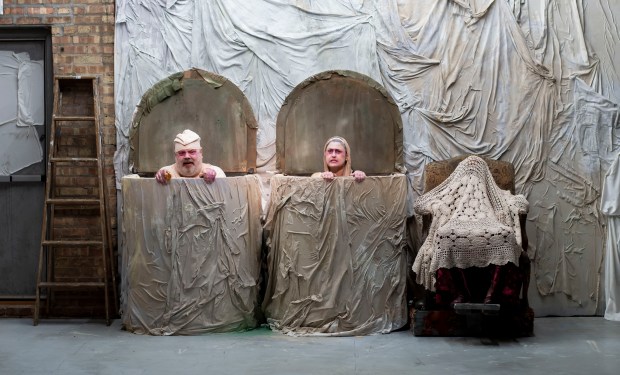If Ebenezer Scrooge found himself isolated in a post-apocalyptic setting, with no one but his elderly parents and his long-suffering servant to haunt his monotonous days, he would probably behave like Hamm, the petty tyrant of a sad little domain in Samuel Beckett’s 1957 play, “Endgame.” In Facility Theatre’s new revival of the Irish playwright’s absurdist tragicomedy, the blind and paralyzed character (played by artistic director Kirk Anderson) looks like a slightly steampunk Scrooge, wearing a silk dressing gown, old-fashioned nightcap and round black sunglasses as he holds court from a shabby upholstered armchair.
But this is Beckett, not Dickens, so don’t look for a redemptive character arc or cathartic ending. Like his better-known 1953 play, “Waiting for Godot,” “Endgame” doesn’t have much of a plot but rather centers on sparse, often nonsensical dialogue with a dash of physical comedy. Amid the rambling non-sequiturs and repetitive exchanges, Beckett drops hard-hitting reflections on the bleakness of a life lived with no authentic human connections.
Facility’s production is directed by Yasen Peyankov, a Steppenwolf Theatre ensemble member and head of the theater department at University of Illinois Chicago. Along with Anderson, the cast includes York Griffith as the servant, Clov, and H.B. Ward and Shawna Franks as Hamm’s parents, Nagg and Nell, who occasionally poke their heads out of the garbage bins where their miserly son keeps them imprisoned. Under Peyankov’s direction, this ensemble effectively conveys the ennui and despair of Beckett’s characters while also capturing the script’s dark humor.
In my experience, watching a Beckett play is best approached like gazing at a surrealist painting. If you let the words and imagery — and the emotions they conjure — wash over you without trying to make logical sense of the action, cogent thematic threads will emerge from the bizarre actions of these strange characters. In Facility’s “Endgame,” the first production of this play that I’ve seen live, I was particularly struck by Beckett’s exploration of toxic familial relationships and the sense of malaise that permeates this dystopian world.
Hamm comes off as self-pitying and demanding from the start, and his capacity for cruelty only becomes clearer when we learn how Clov came to be part of his household as a young child. There’s also the matter of Hamm’s parents, confined to living in their own filth with only dry biscuits for sustenance, though Nagg’s reminiscences reveal that he and Nell were not exactly kind parents when Hamm was a child. While this family history doesn’t justify what can only be described as elder abuse, it does hint at a vicious cycle that didn’t begin with Hamm.
Clov, who doesn’t remember his own father, completes this odd family. Griffith plays this role with a shuffling gait, drooping shoulders and vacant gaze, which form a striking contrast to his occasional bursts of rage. Although the servant admits that Hamm has been like a father to him, their relationship is also highly dysfunctional. The question of whether Clov will leave Hamm recurs throughout the play, epitomized in this asynchronous exchange:
Hamm: “Why do you stay with me?”
Clov: “Why do you keep me?”
“There’s no one else.”
“There’s nowhere else.”
Beckett never specifies what disaster has trapped these characters in a house by the sea, but it seems to have resulted in novel weather patterns, a lack of supplies and no expectation of encountering other survivors. Here, the end of the world seems both baffling and boring. “Why this farce, day after day?,” both Nell and Clov wonder at different points in the play. This question feels all too relatable today, when news headlines seem indistinguishable from satire.
One aspect of the play hasn’t aged so well, though: Beckett’s treatment of disability. Hamm’s blindness and paralysis serve as metaphors for his character traits, and both are occasionally played for comedic effect, albeit a pathetic sort of comedy. Given the evolving conversations about onstage representation of disabilities, I suspect that modern audiences would (rightly) be less forgiving if a contemporary playwright used these devices.
Before this review reaches its endgame, I have to add some praise for the production designers. Doing double duty as both actor and set designer, Anderson uses an off-white fabric with a papier-mâché texture to create a grimy backdrop. Lighting designer Richard Norwood’s overhead fluorescents shine a harsh glare on Bisa’s Victorian-esque costumes, with jarring buzzes from sound designer Rick Sims punctuating the sudden lighting changes. The combined effect lies somewhere between the gloomy, rotting mansion of Miss Havisham (another notorious Dickens misanthrope) and the sterile corporate cruelty of the Apple TV+ series “Severance.”
Facility’s revival of “Endgame” is a rare chance to see this classic work by a playwright who prefigured dramatists such as Tom Stoppard and Harold Pinter. (More significant parallels aside, the characters popping out of barrels in “Rosencrantz and Guildenstern Are Dead” surely owe something to Nagg and Nell.) In Facility’s home base, located just across the street from the green expanse of Humboldt Park, Peyankov and team have skillfully harnessed the resources of a storefront theater to make Beckett’s “corpsed” world feel utterly real.
Emily McClanathan is a freelance critic.
Review: “Endgame” (3.5 stars)
When: Through June 29
Where: Facility Theatre, 1138 N. California Ave.
Running time: 1 hour, 40 minutes
Tickets: $30 suggested donation (pay-what-you-can options available) at facilitytheatre.org





